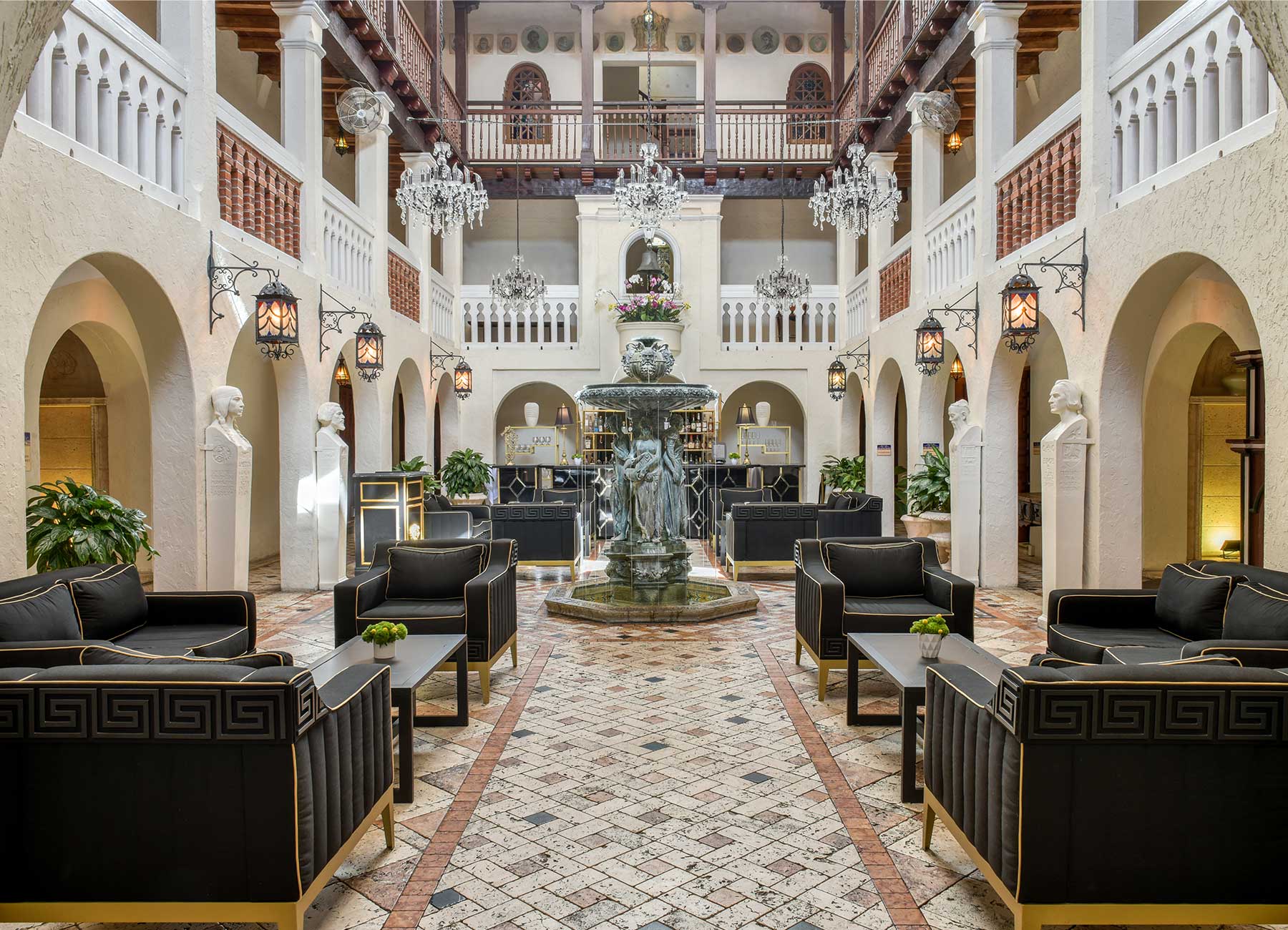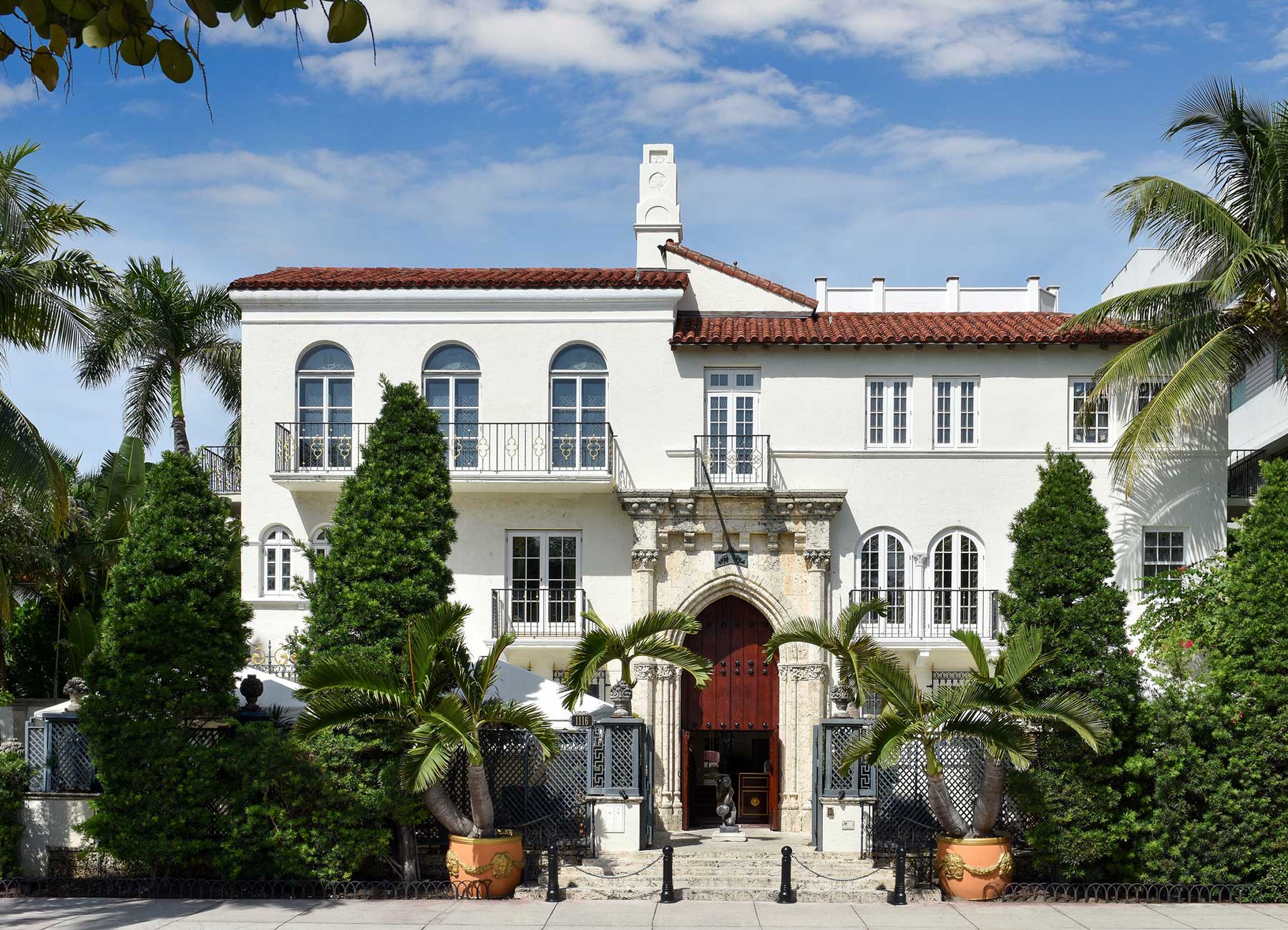
Home » About the Villa
The Villa Casa Casuarina
HISTORY OF THE PROPERTY
Casa Casuarina was built in 1930 by Alden Freeman. Alden Freeman’s father, Joel Freeman was Treasurer of The Standard Oil Trust (also known as Rockefeller’s Company) and left Alden a fabulous wealth when he passed away. That gave the young and wealthy Alden the opportunity to retire at the age of 27 from being an architect and travel all over the world. Alden was also a descendent of the Mayflower on his mother’s side and felt a very strong tie to history. Freeman, always well-travelled and very intelligent, loved the adventurous spirit of Christopher Columbus and on one of his many trips around the world, went to visit the Alcazar De Colon in Santo Domingo (Dominican Republic) which was built by Diego Columbus (Christopher Columbus’s Son) and is known for being the oldest residence in the western hemisphere. Alden was so inspired by the house that he decided to build his own home in Miami Beach as homage to the Alcazar De Colon and bought back 2 bricks from the house. One sits to the right hand side of the main entrance and one sits in his former house in the city of Santa Barbara, California (named the “Montarioso” estate, which was later donated to the city and was then restored and studied by the Pearl Chase Society of Santa Barbara). Alden dreamed of living in a bohemian society with all of his friends from local areas such as Coconut Grove and Coral Gables. In addition, on his many trips abroad he would meet fascinating people and always invite them to hang out in his beautiful home here in Miami Beach.
The Hubbell & Hubbell Company was the contractor responsible for the construction of Casa Casuarina. If you look down, you will see that the ground is original key lime coral, which was part of the original house designed by noted 1920s interior designer Addison Mizner who virtually created West Palm Beach.
The property had a total of 24 apartments. Freeman lived in the top-floor-front apartment on the southeast corner. The remaining 23 apartments in the building were available for rent and to house many of Freeman’s friends that visited Miami Beach.
Alden Freeman died at Casa Casuarina on December 29, 1937 following a prolonged illness. The house was then sold to Jacque Amsterdam for $100k, who continued to run the house as an apartment complex that he named the “Amsterdam Palace. In April 1939, Amsterdam did a small renovation of the house in which he installed an elevator shaft (where the current bell is located), replaced the lily pond in the Courtyard with terrazzo flooring and moved the kneeling Aphrodite statue to the front terrace. Rooms were rented for $600/month during winter season and $30/month in the summer.
In the ensuing years, Amsterdam Palace passed through the hands of several owners and hundreds of tenants. For a short time in the 1980’s, the house was called Christopher Columbus Apartments. After a while, the building gradually felt into disrepair, but miraculously, most of the original fittings and artworks survived.
In 1992, while on vacation with his family in Miami Beach, Versace took a walk down Ocean Drive and was immediately attracted to the house by the “Kneeling Aphrodite” statue and fell in love with the unique Spanish architecture of the property. Obsessed with Greek and Roman mythology, Versace purchased the original house built by Freeman for $2.95 million and the lot next door, an old art deco hotel called the Hotel Revere. Although this neighborhood was placed on the National Register of Historic Places in 1979 and despite strong opposition from the Miami Design Preservation League, Versace bought the Revere Hotel next door for $3.7 million in order to demolish it and put in the Garden, Swimming pool and South Wing.
Versace invested an additional $32 million in renovations in which he added the south wing, the pool and garden and turned the 24 apartments into 10 large suites in the original house and an additional 2 new suites in the south wing. He also removed the elevator shaft in the Courtyard, replaced the fountain and reconstructed the observatory, including a new copper dome. Versace had planned to buy the then-vacant lot next door to the north in order to put in a second garden, but when his death intervened it became part of the Victor Hotel.
The renovations took almost 3 years to complete and in July 15, 1997, only 5 yrs after purchasing the home, Versace was killed on the front steps of the house on his usual morning walk home from News Cafe.
In addition to Gianni Versace, the house was also used by his many close friends and family members. His brother Santo’s bedroom is now called the Venus room, his sister Donatella’s bedroom is the Signature suite.
Some contents of when Versace lived here were auctioned in New York City in April of 2001 for a reported $28 million. What still remains here from the Versace era are the richly decorated walls, floors, ceilings, and windows, as well as the pool, garden, and the entire south wing.
The house sat empty for about 3 years and in September of 2000, Donatella finally sold the property to Peter Loftin, a telecommunications magnate from Raleigh, N.C. for $19 million. Loftin used this house as a private residence as well as a hotel, membership club and private events venue from 2001 to the end of 2009.
In December of 2009, Events impresario and restaurateur Barton G. Weiss leased the property and took over the Mansion, imprinting his own signature style on the storied house and reopened as The Villa by Barton G. In September 2013 Florida business connected to Jordache Enterprises bought the Mansion at auction with a winning bid of $41.5 million.
Legend maintains that Casa Casuarina was the original name given to the house when it was built in 1930 as homage to the only remaining tree in the lot after the 1926 hurricane that hit South Florida. Freeman was forced to cut down the tree in order to make room for the construction of his new house. Casuarina esquisetifolia is the botanical name of the tropical tree popularly known as the “Australian Pine”.
HISTORICAL ITEMS
Bronze statue: The Kneeling Aphrodite (the Greek goddess of love) is a very special statue to the house and has been here since the house was built. It was sculpted in 1928 by a relatively unknown Yugoslavian sculptor named Vuk Vuchinich (Vukinich).
Vuchinich was one of Freeman’s protégés and was listed in Who’s who in American Art when this statue was first seen in a Sculpture exhibit in San Francisco in 1929.
The kneeling Aphrodite sat in the courtyard until Jacque Amsterdam moved it to the front of the house to welcome people with love. Walking into the Courtyard: On the left wall of the staircase, you will see a circle with a medusa in it. The medallion is meant to symbolize the shield of Perseus, who be-headed Medusa and put it on his shield to protect him when he went into battle. He later gave this shield as a gift to Athena, the goddess of all the gods to keep her protected from evil spirits.
The Fountain: The fountain in the Courtyard was purchased by Peter Loftin. The base was created in 2004, when Peter made some changes to the house but the fountain itself was an antique, purchased in France and restored in the US. It’s an amazing fountain that combines all the different and unique aspects of the house.
The 4 White Pillars: These 4 white pillars that surround the courtyard are called the “pillars of democracy” and were designed by Ulric Henry Ellerhusen.
These 4 pillars represent the 4 continents along with the 4 characters that Freeman felt most influenced the new world:
• Europe (Columbus), Asia (Confucius), Africa (Frederick Douglass) America (Pocahontas). The Bell: A mission bell from California also decorated the Courtyard when Freeman lived in the property. The original bell was later replaced by a different bell made in Philadelphia in 1851 during Versace’s renovations.
Portrait Medallions: Approximately 130 mostly disc-shaped decorative medallions line the upper story of the Courtyard. Approximately 85 identical or similar plaques still exist at Freeman’s “Montarioso” house in Santa Barbara.
Their subject matter is very eclectic, ranging for portraits of Cleopatra, Mussolini, Gandhi, Lenin and John D. Rockefeller. Essentially, they portray people, places, and historical events that intrigued Alden Freeman, including many of his own personal friends, his own ancestors, and their accomplishments.
Mosaic Garden: As you walk down to the base of the stairs please note that everything past the white wall is all part of the “New Wing” Versace built in 1992. You will also notice that the new wing is almost completely made up of small mosaic tiles.
At the base of the stairs you have Neptune, the God of water and sea. The Medusa in the pool garden is the largest in the whole house. This Medusa was done in Versace’s home town of Calabria Italy, broken apart and then shipped to Miami Beach in numbered segments. The Medusa in the pool garden is also his logo which is the Medusa surrounded by the Greek key which represents an infinite pattern. When used in a circle can also mean Infiniti which is how Versace used it.
The Pool AKA the “Million Mosaic Pool”: The pool was inspired by Versace’s “Marine Vanitas” collection and contains thousands of 24k gold tiles. The main character of the pool is Poseidon, the God of the Sea.
The 4 Large Urns on both sides of the pool were designed by Versace and have another sometimes sing to people and gods and enchant them; distracting them from their work and causing them to walk off the deck or run their ships aground.
Other stories have them squeezing the life out of drowning men while attempting to rescue them. If you look around the pool, you will see the same symbolism Versace loved (circles, squares and triangles).
Open Rotunda: Rotundas are widely used all over Europe, especially in Greece and Rome for their natural air-conditioning benefits. The large rug that is hanging on the wall was purchased by Versace and framed in beautiful stone.
The rug depicts the village of the gods welcoming home Aphrodite-Goddess of Love and even shows a woman getting a little cupid ready for Aphrodite.
On the top right, you can see the Temple of the Gods with Athena and Zeus as well as Poseidon, who is sitting with his Triton. The floor is a pattern of triangle and diamonds within circles around the shells and pearls in the center.
